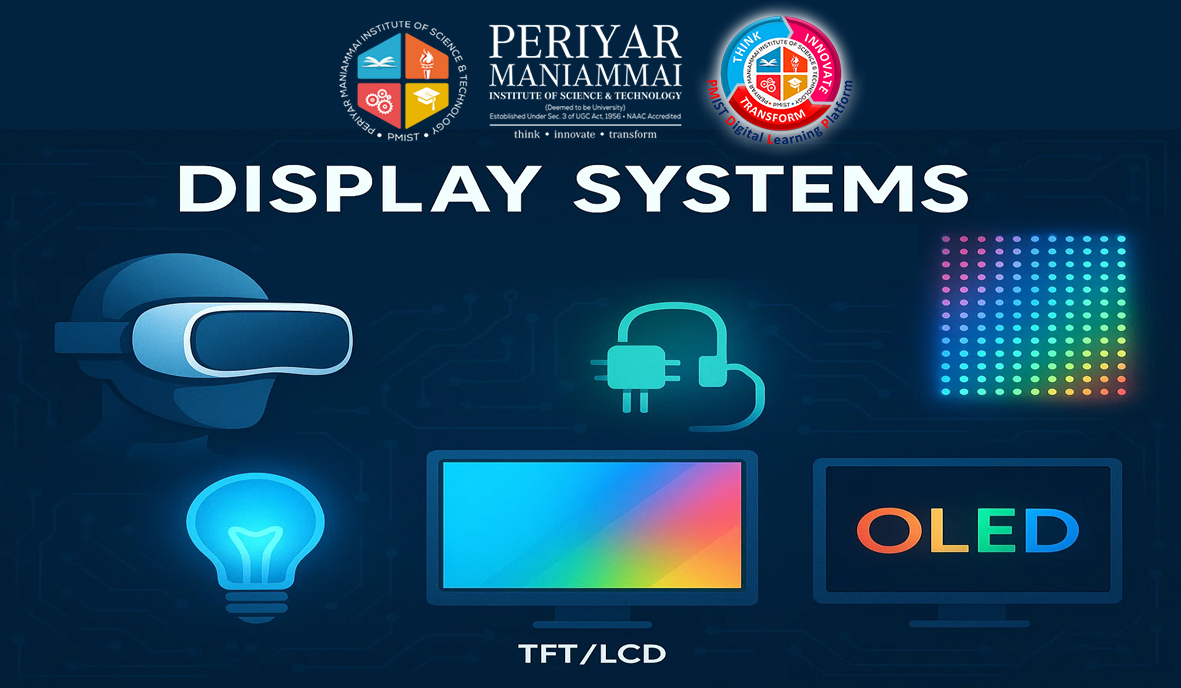

Note: Please check your Spam or Junk folder, in case you didn't receive the email with verification code.
Adaptive:Personalised Learning
This course provides an in-depth understanding of display technologies used in modern electronic and visual systems. It covers a wide range of display types, including head-mounted displays, low-power lighting systems, TFTs, LCDs, and various emissive displays. Students will explore the technical requirements, working principles, and recent advancements in display device technologies.
By the end of the course, students will be able to:
Understand the operational principles and technical specifications of various display systems
Analyze the working of head-mounted displays and their applications
Evaluate different types of low-power lighting systems used in displays
Understand the structure and functioning of TFTs and LCDs
Compare and contrast different emissive display technologies
Identify recent trends and innovations in display technology
Introduction to display systems
Classification and applications
Technical requirements for different display types
Parameters: resolution, refresh rate, brightness, contrast ratio
Environmental and energy considerations
Principles of head-mounted displays
Optical design and ergonomics
Types: monocular, binocular, augmented reality (AR), virtual reality (VR)
Applications in gaming, training, and industry
Challenges in design: latency, field of view, power consumption
Overview of lighting technologies in displays
LED and OLED technologies
Power efficiency and thermal management
Backlighting techniques in LCDs
Energy-saving display strategies
Structure and function of Thin Film Transistors (TFTs)
Construction and working of Liquid Crystal Displays (LCDs)
Active vs. passive matrix displays
Color generation and pixel control
Advantages and limitations of LCD/TFT displays
Cathode Ray Tube (CRT) fundamentals
Plasma Display Panels (PDP)
Organic LED (OLED) and MicroLED displays
Electroluminescent and field emission displays
Comparison of emissive vs. non-emissive systems
Flexible and foldable displays
Transparent and 3D displays
Quantum dot technology
E-paper and reflective displays
Future trends: holographic, stretchable, and nano-based displays
This module introduces the basics of display technologies, the requirements of various applications, and the technical parameters that define display performance. It sets the foundation for understanding how and why display systems differ.
 Fundamentals of Display Systems
Fundamentals of Display Systems
 Disp Sys - Assessment 1
20 Questions
Disp Sys - Assessment 1
20 Questions
Explores the structure, functioning, and application of head-mounted displays. The focus is on immersive technologies including virtual and augmented reality, and the design challenges specific to wearable visual systems.
 Head-Mounted Displays (HMDs)
Head-Mounted Displays (HMDs)
 Disp Sys - Assessment 2
20 Questions
Disp Sys - Assessment 2
20 Questions
Covers energy-efficient lighting technologies used in displays. Emphasizes LED and OLED systems and how they are integrated into display devices to minimize power consumption while maintaining visual quality.
 Low-Power Lighting Systems
Low-Power Lighting Systems
 Disp Sys - Assessment 3
20 Questions
Disp Sys - Assessment 3
20 Questions
Discusses the inner workings of TFT and LCD-based displays, including pixel operation, matrix types, and color control. Focus is placed on understanding how these technologies dominate current flat-panel display markets.
 TFT and LCD Display Technology
TFT and LCD Display Technology
 Disp Sys - Assessment 4
20 Questions
Disp Sys - Assessment 4
20 Questions
Introduces self-light-emitting displays and explains their advantages over non-emissive types. This includes detailed discussion on OLEDs, plasma, and newer MicroLEDs, with an emphasis on performance, durability, and applications.
 Emissive Display Technologies
Emissive Display Technologies
 Disp Sys - Assessment 5
20 Questions
Disp Sys - Assessment 5
20 Questions
Covers the latest innovations such as foldable, transparent, and holographic displays. Students will examine how cutting-edge materials and nanotechnology are shaping the future of display devices.
 Recent Advancements in Display Technology
Recent Advancements in Display Technology
 Disp Sys - Assessment 6
20 Questions
Disp Sys - Assessment 6
20 Questions
 Disp Sys - Final Assessment
50 Questions
Disp Sys - Final Assessment
50 Questions
The certificate issued for the Course will have
Only the e-certificate will be made available. No Hard copies. The certificates issued by Periyar Maniammai Institute of Science & Technology (PMIST). can be e-verifiable at www.ulektzskills.com/verify.



 90 hours Learning Content
90 hours Learning Content 100% online Courses
100% online Courses English Language
English Language Certifications
Certifications